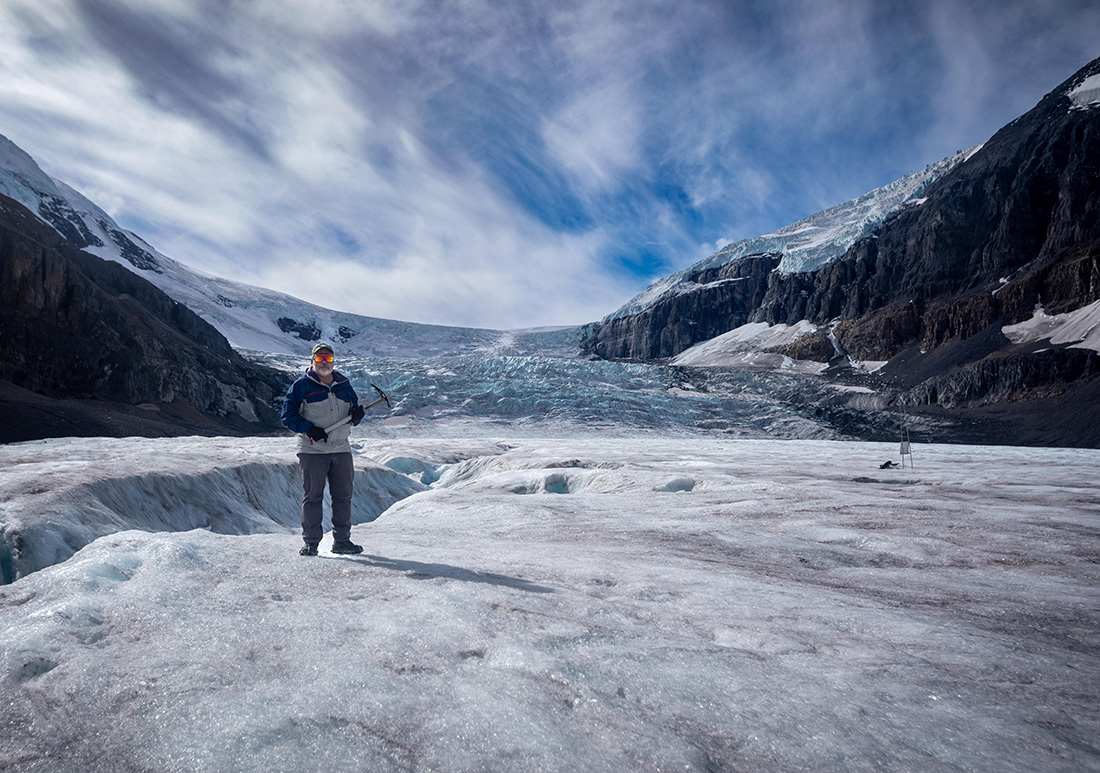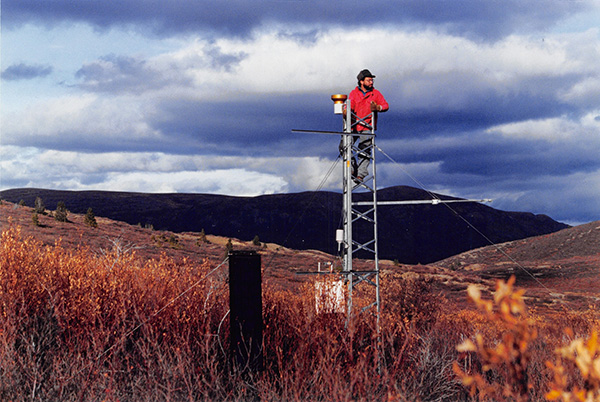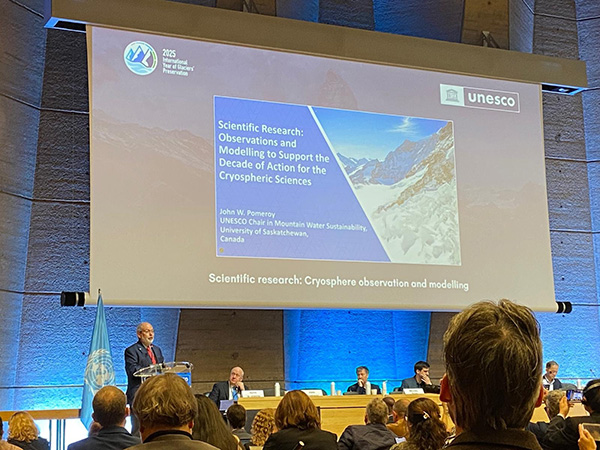
Frozen Frontiers and Global Impact: Five Questions with Dr. John Pomeroy
In this special feature, we ask Dr. Pomeroy five questions to reflect on what being awarded the prestigious Dooge Medal means to him, the inspirations and impacts of his career, and the future challenges and hopes for our water.
The Global Institute for Water Security is proud to celebrate a landmark achievement by Dr. John Pomeroy (PhD), who has been awarded the prestigious Dooge Medal—one of the highest international honors in hydrological sciences. Presented by the International Association of Hydrological Sciences, UNESCO, and the World Meteorological Organization, the Dooge Medal recognizes Dr. Pomeroy’s groundbreaking work in cold regions hydrology, climate change impacts, and water security. Dr. Pomeroy is the third GIWS faculty member to receive this award (Jeffrey McDonnell 2016, Howard Wheater 2018).
In this special feature, we ask Dr. Pomeroy five questions to reflect on what this recognition means to him, the inspirations and impacts of his career, and the future challenges and hopes for our water.
Congratulations on receiving the Dooge Medal! What does this recognition mean to you personally and professionally?
It is an honour to be named and exciting to have such recognition going to the University of Saskatchewan and to the field of snow and ice hydrology. Over the 46 years since I started at as an undergraduate student at USask, I have worked with hundreds of students, professors, technicians, engineers, scientists, assistants and colleagues from around the world – but mostly from USask. This is really a recognition of our collaborative efforts to advance the science of cold regions, prairie, northern and mountain hydrology and the University of Saskatchewan has been front and centre in this advance.
The Dooge Medal recognizes outstanding contributions to the advancement of hydrological science. What aspects of your research do you think have had the greatest impact on the field?

Not all of my research has been on snow, but much of it has been because it is fascinating to study and important to our water resources; snowmelt provides about 4/5th of streamflow generated in the Prairies and is an important replenishment of soil moisture for spring planting. I simply love snow and find it fascinating as a physical material, even as a kid I liked to build snow forts and throw snowballs. But snow has even more fascinating physical, chemical and ecological properties – it blows in the wind, almost like sand, in a complex mechanism called two-phase flow, but in a different way that I was able to explore as part of my PhD under the direction of Don Gray and David Male from the Division of Hydrology, College of Engineering at USask. With the help of Tom Brown from the Division of Hydrology we were able to understand the light scattering properties of blowing snow and use this to design and build an opto-electronic blowing snow gauge in 1984. We installed these and a computer-controlled weather station for winter field studies of blizzards, and I worked out of a trailer near Loreburn, Sask. for several winters taking measurements in snowstorms. From this research came the basic theory of blowing snow transport and sublimation (evaporation from ice to vapour). The method and results are used by Saskatchewan farmers to manage their snow through tall stubble and by glaciologists to calculate the mass balance of the Greenland and Antarctic icesheets.
Later, working with Newell Hedstrom and others at Environment Canada’s National Hydrology Research Institute on campus we hung a full-size spruce tree from a weigh scale off a tall tower in Prince Albert National Park and showed that forest canopies can intercept large amounts of snow and that much of this snow then sublimates back to the atmosphere. The results are used around the world to understand the impact of forest disturbance due to harvesting, disease or wildfires on snowmelt water supply.
Your research has transformed how we understand and model cold region hydrology. What initially drew you to this field, and what keeps you inspired today?
When I was a teenager, I had a plan to walk the coast of Hudson Bay. I had to change plans and walked across part of Baffin Island instead. It was a life-changing challenge that got me interested in the Arctic and cold regions. I found that USask had a Northern Studies Institute and strong research on cold regions, so I switched from being an Astrophysics major at a US university and came to complete a BSc in Geography and then a PhD in Agricultural Engineering at USask. As an undergraduate, three geography professors had tremendous influence; first William Barr took me to and helped me understand the Canadian Rockies glaciers and snowfields, then John FitzGibbon got me involved in research on the South Saskatchewan River as part of the Meewasin Valley Baseline Study, and then Robert Bone involved me in his studies of oil pipeline impacts on the people of the Mackenzie River Valley - and that was the start of my journey as an environmental scientist and eventually a hydrologist. My graduate studies on snow hydrology supervised by Don Gray and Dave Male was wonderful – they were considered the best in the world in cold regions hydrology and had just written a massive 776 page “Handbook of Snow”. The USask Division of Hydrology was a dream to train in and I have remained primarily a snow and ice hydrologist to this day.
You've worked across a range of hydrological topics and regions. How has your research evolved over the years, and what has remained constant?
My research started on Prairie agricultural water management and moved on to mountain forest snow hydrology in the US (with R.A. Schmidt, US Forest Service) on the water problems of the Colorado River, and then in the UK on acid snow chemistry during Scottish Highland snowstorms (with Trevor Davies, University of East Anglia). I then returned to Saskatoon to work at Environment Canada’s NHRI with Wally Nicholaichuk, Raoul Granger, and Phil Marsh, on agricultural, forest and arctic hydrology, and with Al Pietroniro on developing physics-based hydrological models. Together with Don Gray, we authored a book on snow covers published by Environment Canada. I also helped establish the field of snow ecology with Gerry Jones from the Université du Québec, culminating in the first book on the subject. We established many instrumented research basins in the arctic, subarctic, boreal forest and prairies.
The problem of predicting water flow in ungauged basins is a serious one for Canada and many other countries with insufficient streamflow gauges and the need to predict streamflow under changing climate or land cover. While at the University of Wales as its first Professor of Hydrology, I helped initiate the International Decade for Predictions in Ungauged Basins (PUB), and later chaired PUB while at the University of Saskatchewan as a Canada Research Chair, advancing physics-based models that could predict streamflow without calibration.
In the Centre for Hydrology, founded in 2004 as a successor to the Division of Hydrology, I have had major research projects on prairie drought, prairie wetlands, mountain and polar hydrology, and continued to develop models with Al Pietroniro. Collaborating with colleagues like Kevin Shook, we made major strides in understanding wetland dynamics and their broader hydrological impacts.
Later, I was part of establishing the Global Institute for Water Security (GIWS) and the USask Coldwater Laboratory in Canmore, Alberta. Working with Howard Wheater and others, we expanded cold regions research and launched the Global Water Futures (GWF) program—the largest freshwater research initiative in the world, involving 23 universities, hundreds of professors and thousands of students and scientists to best forecast, prepare for and manage water futures in the face of increasing risk. It has since evolved into GWF Observatories, a national network supporting freshwater research at nine universities across Canada. It provides a great legacy of returning Canada to the forefront of water research, leaves a strong and renowned GIWS at USask, and has dealt with dozens of major water issues, from invasive species in our lakes, to Indigenous community health, to melting glaciers and prairie farm water supply. We also created the hydrological models and water science that the federal government, many provinces and countries around the world use for their river management, forecasts and predictions. Most importantly, we have trained thousands of students in water science – they are the next generation of experts who will shepherd the world to a better water future.
Constant through all of this has remained the excitement of discovery of fundamental hydrological processes, the use of cutting-edge technology in measurements and modelling and in maintaining exceptionally high standards and integrity in research whilst being open to discussing the outcomes with anyone who is interested.
Looking ahead, what are the most urgent challenges hydrologists must address, and what gives you hope?

We live in a time of unprecedented climate change and unsustainable development which is making the hydrology of the world unrecognisable by increasing floods and droughts, melting glaciers and permafrost and changing the timing and volume of water supplies for billions of people. To address these, I have helped propose what became the new Canada Water Agency to better manage Canada’s waters, the UNESCO Chair in Mountain Water Sustainability with Corinne Schuster-Wallace at USask, the Universities of Calgary, Chile and Tribhuvan University (Nepal), the UN’s International Year for Glaciers’ Preservation – 2025 and the UN Decade of Action for Cryospheric Sciences. These initiatives provide a framework within which excellent and pertinent fundamental research can be conducted. With a warming world, changing supplies and more extreme water disasters, and a need to develop more sustainable water futures with equity and inclusion of all of society, there has never been a more important time for water scientists to address the grand challenges posed by nature and to do this working with communities and industries to co-develop solutions that can make lives better and communities safer and more prosperous. Saskatchewan in particular has a water-based economy, water-limited agriculture, strong Indigenous culture that appreciates water is life, and millions of beautiful lakes, wetlands and rivers and so the more we know about water the better we can develop our economy whilst conserving our environment and water heritage.
